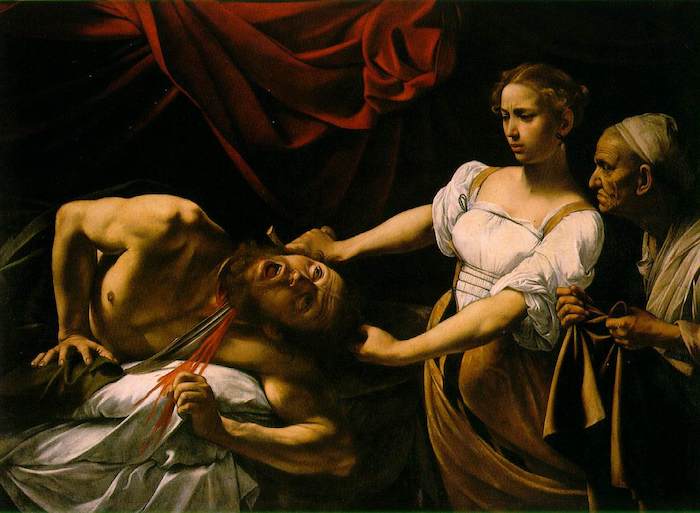Exeter Riddle 45
MEGANCAVELL
Date: Wed 07 Oct 2015Matching Commentaries: Commentary for Exeter Riddle 45
Ic on wincle gefrægn weaxan nathwæt,
þindan ond þunian, þecene hebban.
On þæt banlease bryd grapode,
hygewlonc hondum. Hrægle þeahte
5 þrindende þing þeodnes dohtor.
I heard that something was growing in the corner,
swelling and sticking up, raising its roof.
A proud bride grasped that boneless thing,
with her hands. A lord’s daughter
5 covered with a garment that bulging thing.
Notes:
This riddle appears on folio 112v of The Exeter Book.
The above Old English text is based on this edition: Elliott van Kirk Dobbie and George Philip Krapp, eds, The Exeter Book, Anglo-Saxon Poetic Records 3 (New York: Columbia University Press, 1936), page 205.
Note that this edition numbers the text Riddle 43: Craig Williamson, ed., The Old English Riddles of the Exeter Book (Chapel Hill: University of North Carolina Press, 1977), pages 96-7.
Tags: anglo saxon exeter book riddles old english solutions riddle 45
Related Posts:
Commentary for Exeter Riddle 43
Commentary for Exeter Riddle 42
Exeter Riddle 44
 >
>

Commentary for Exeter Riddle 45
MEGANCAVELL
Date: Wed 07 Oct 2015Matching Riddle: Exeter Riddle 45
Riddle 45 is yet another example of a riddle that’s simply throbbing with double entendre. In case you hadn’t noticed.
The interpretation most widely accepted is that the riddle refers to bread dough (OE dag). After it rises, the woman in the riddle kneads and shapes it and then puts a piece of cloth over it. But of course this is all masked by the har-dee-har-har references to a bride grasping a banleas (bone-less), swelling thing and then covering it with her garment. Apparently, bread-making is an erotic activity. Who knew?
Look at that sexy, sexy kneading.
Dough after kneading. Looking good.
Photo (by ElinorD) from the Wikimedia Commons.
Dough after rising. My how you’ve grown.
A hint about why the poem refers to a woman of high status (i.e. the daughter of a þeoden or “ruler” / “lord”) may lie in the Old English word hlafdige. Although this term, which literally seems to have meant “loaf-kneader,” only appears a couple of times in the Old English written record, it’s the root of our modern English word “lady” (compare to hlaford (lord), whose etymological roots point to the meaning: “loaf-keeper”).
The woman is also referred to as hygewlonc (proud in mind), which Mercedes Salvador-Bello reminds us is often associated with sexual activity (page 85). In fact, proud-minded swelling is also found in other texts that are linked to this poem by the use of the term þrindende (swelling) (page 83). Although this particular spelling is unique to Riddle 45, scholars have argued that it’s the same word that appears in the poem Vainglory at line 24b (translation here) and in Riddle 37 at line 2a. In the first example, we see that pride swells up (þrinteð) within an arrogant man. In the second, another rather sexually explicit riddle, the belly or womb of a bellows is swollen (aþrunten) with air. So, if we accept that these words are all related, then there seems to be a basis for playing on a link between sex/pride/swelling.
But there also seems to be a bread/sex link that goes beyond the hard work of kneading a loaf with a pair of particularly grabby hands, like those imagined in Riddle 45. As Thomas D. Hill points out, the tenth/eleventh-century continental bishop Burchard of Worms includes an interesting passage in his treatise on canonical law, the Decretum. Book 19 of this text declares:
Fecisti quod quaedam mulieres facere solent? Prosternunt se in faciem, et discoopertis natibus, jubent ut supra nudas nates conficiatur panis, et eo decocto tradunt maritiis suis ad comedendum. Hoc ideo faciunt, ut plus exardescant in amorem illarum. Si fecisti duos annos per legitimas ferias poenitas. (section 974)
(Hast thou done as certain women are accustomed to do? They lie down on their face and having uncovered their buttocks, they order that bread should be made upon [their] nude buttocks; and having cooked it they give it to their husbands to eat. This they do so that they [their husbands] should burn with love for them [the wives]. If thou hast done this, thou shalt do penance for two years on the appointed days.) (translation from Hill, page 54)
Apparently this was a thing that some women did…
And Burchard considered it to be quite a bad thing to do (magic! stomp it out!), judging from the long penance that he demanded. I don’t know about you, but I’ll be thinking of this next time an elderly family member refers to someone’s bottom with the term “buns.” (or is my family just weird?)
The long and the short of all this is that, as Hill points out, “Dough is the material which a woman uses to nourish her family; it is potentially a rich symbol of a woman’s power within the home, and the way in which it rises (apparently) spontaneously can provide the basis for erotic metaphor” (page 59).
While I understand why the sexually-charged imagery of Riddle 45 has been interpreted this way, I still can’t help reading this riddle and thinking of pregnancy rather than penises. It’s the phrase “bun in the oven,” as well as caressing and covering of a swelling, bread-shaped body-part that makes reminds me of a pregnant belly. And this would of course still invite a sexual reading (because of the lead-up to pregnancy, not some yummy-mummy fetish). The only hiccup in this interpretation is the banleas (bone-less) nature of the swelling thing, although a bit of digging into early theories of fetal development demonstrates that this isn’t really an issue.
An Old English text known as De generatione hominis (on the generation of a human) is found on folio 38b of the manuscript London, British Library, Cotton Tiberius A.iii (see Deegan, page 23). Part of it reads:
On þam feorþan monþe he bið on limum staþolfæst. On þam fiftan monþe […] þa ribb beoð geworden, þonne gelimpð þære manigfeald sar þonne þæs byrþnes lic on hire innoþe scipigende bið. On þam syxtan monþe he byþ gehyd, ond ban beoð weaxende. (Cockayne, vol. 3, page 146)
(In the fourth month it is firm in limbs. In the fifth month […] the ribs are formed, then various troubles occur when the body is forming inside the bearer. In the sixth month it is provided with skin, and the bones are growing.)
So, bone-less-ness isn’t a problem for my pregnancy reading of Riddle 45, since even a fetus in the second trimester was thought to not yet have bones by the writer of this early English medical text! You learn something new everyday…
Righto, I’m going to leave it there today. Feel free to sift through my commentary and post any comments/questions that rise up!
References and Suggested Reading:
Burchard of Worms. Decretum. Patrologia Latina Database. Vol. 140.
Cockayne, Thomas, ed. Leechdoms, Wortcunning, and Starcraft of Early England. 3 vols. London: Holland Press, 1961.
Deegan, Marilyn. “Pregnancy and Childbirth in the Anglo-Saxon Medical Texts: A Preliminary Survey.” In Medicine in Early Medieval England. Edited by Marilyn Deegan and D. G. Scragg. Manchester: Centre for Anglo-Saxon Studies, University of Manchester, 1987, pages 17-26.
Hill, Thomas D. “The Old English Dough Riddle and the Power of Women’s Magic: The Traditional Context of Exeter Book Riddle No. 45.” In Via Crucis: Essays on Early Medieval Sources and Ideas in Memory of J. E. Cross. Edited by Thomas N. Hall and Charles D. Wright. Morgantown: West Virginia University Press, 2002, pages 50-60.
Salvador(-Bello), Mercedes. “The Key to the Body: Unlocking Riddles 42-46.” In Naked Before God: Uncovering the Body in Anglo-Saxon England. Edited by Benjamin C. Withers and Jonathan Wilcox. Morgantown: West Virginia University Press, 2003, pages 60-96 (esp. 82-6).
I also wrote a piece on this riddle for the British Library's Discovering Literature website, which you can access here.
Tags: anglo saxon exeter book riddles old english solutions riddle 45
Related Posts:
Commentary for Exeter Riddle 37